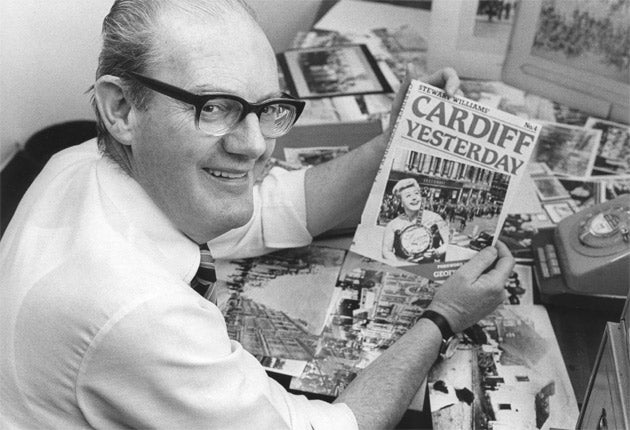Stewart Williams: Noted publisher whose books brought the history of Cardiff to life

"I'm Cardiff born and I'm Cardiff bred, and when I dies I'll be Cardiff dead." Although Stewart Williams died a few miles outside the city's boundaries, Frank Hennessy's song always brings him to mind. For the publisher and local historian who devoted his energies, and in the early days a lot of his own money, to recording Cardiff's growth from sleepy fishing village to the largest coal-exporting port in the world and then, in our own time, to administrative capital of Wales, was a proud Cardiffian.
In all he published more than 100 books that are admired by general readers and academic historians alike, in particular the 36-volume series Cardiff Yesterday, which includes an important archive of some 7,500 black-and-white photographs. The first volume, published in 1980 to coincide withthe 75th anniversary of Cardiff'selevation to city status, was the template for the rest in that it illustrated various aspects of the city's life, in war and peace, the photos arranged chronologically and with captions providing valuable information about the places, buildings and people who appeared in its pages.
From the start, Stewart Williams' enthusiasm for his birthplace was to the fore: "Cardiff is a city of contrasts, a sprawling amorphous mass of vowel-flatteners chanting CARDIFF on cold, wintry Saturday afternoons at Ninian Park; it is Roath Park in all its colourful glory at rose blooming time; or its less perfumed backstreet pubs where old timers sup the familiar local brew with dedicated single-mindedness; or it is the marble splendour and magnificence of the still beautiful Civic Centre." One heard the famous vowel-flattening in everything he wrote, so that "Cardiff", for example, in the local dialect, is invariably pronounced "Kairdiff".
Stewart Williams was born in Roath, Cardiff, but brought up in Ely, one of the less affluent suburbs mostly made up of housing estates on the city's western side, but taught himself the rudiments of historiography the better to understand the wider urban context and present his research in ways accessible to readers with little or no academic backgrounds. His passion for sharing his knowledge with ordinary readers was the lodestar of his career but he was also a director of the Glamorgan County History Trust and a vice-president of the Glamorgan History Society, at whose meetings he rubbed shoulders with the great and the good.
He had begun by producing bootleg football programmes and souvenirs for Cardiff City, the Bluebirds, a team that commanded his lifelong support. Having moved from the Engineering Department of the City Council to a job as publicity officer with the Western Welsh bus company, he found himself learning skills such as lay-out, point-size and caption-writing that were the foundation of the printer's and journalist's craft in the days of letter-press.
The runaway success of the Cardiff Yesterday series enabled him to take up full-time publishing in 1977 and by 1980 he had published 50 books from his home in Barry. His children, Robert and Diane, together with his wife Betty, helped with everything from proof-reading to deliveries, so that the business was very much a kitchen-table affair at the outset. By the time the 36th volume appeared Stewart Williams was one of the largest publishers of local history anywhere in Britain but still operated from home.
I saw him last at a book fair in Cardiff at which I recall discussing with him how, while human memory is notoriously fallible, photographs record the changing scene with a degree of accuracy. He told me there was no shortage of material because his bookshad opened the floodgates of reminiscence and people kept on offering him images that he could weave into a rich gallery of places and scenes reflecting the life of the city over a century and a half. Profit was never one of his aims, he said: his was a mission to educate his fellow Cardiffians, and anyone else with an interest in the history of the Welsh capital.
Although he had had no highereducation beyond the age of 16, Stewart Williams enjoyed the confidence and esteem of academic and professional writers such as Ewart Parkinson, Director of Environment and Planning for South Glamorgan, the architect John B Hilling, D Morgan Rees of the National Museum of Wales, and Geraint Talfan Davies, Assistant Editor of the Western Mail, all of whom contributed to his symposia, The Cardiff Book. A similar roster of distinguished names contributed to his series Glamorgan Historian.
Such was the popularity of his Cardiff books that Stewart Williams was asked to produce similar volumes on the Rhondda, Ebbw Vale, Cowbridge, Abergavenny, Bridgend, Caerffili, Barry and Aberystwyth, and another on Welsh rural life. Among reprints were his editions of Rice Merrick's Booke of Glamorganshires Antiquities and the classic book by Wirt Sikes, American Consul in Cardiff, Rambles and Studies in Old South Wales. He also published Herbert Williams's Stage Coaches in Wales and Vintage Buses and Trams in South Wales, which again appealed to specialist enthusiasts and readers nostalgic for a bygone age.
Meic Stephens
Stewart Williams, publisher: born Cardiff 12 December 1925; married Betty Stocker (deceased; one son, one daughter); died Llandough, Vale of Glamorgan 13 January 2011.
Join our commenting forum
Join thought-provoking conversations, follow other Independent readers and see their replies
Comments